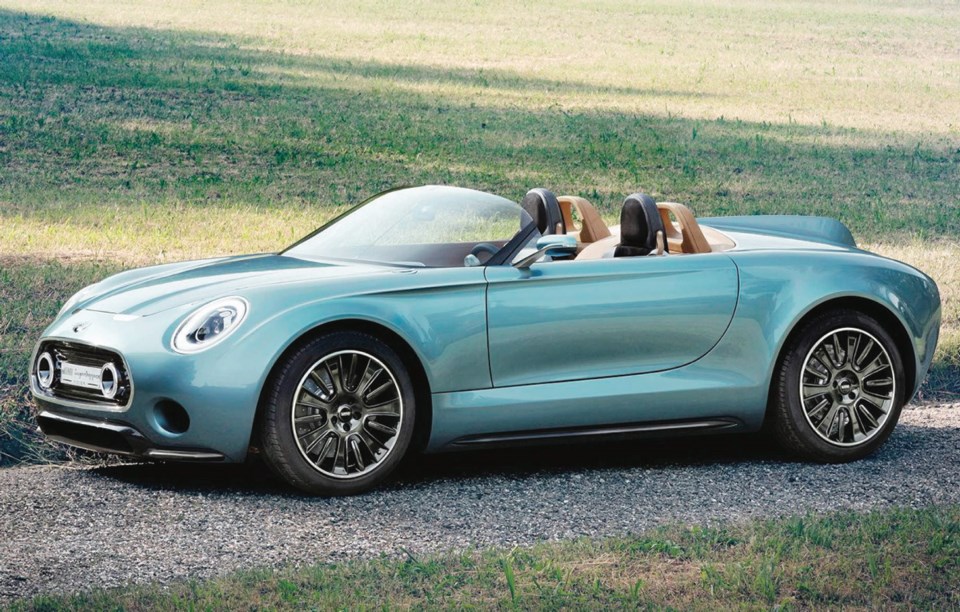The Trenchcoated one was disappointed to hear that BMW’s Mini brand was cancelling its two-seat Cooper Coupe and Roadster after the 2015 model year. On the other hand, he’s now elated after discovering that the Mini Superleggera Vision Concept that was first displayed in Italy several months ago will reportedly enter production in 2017. Although some design elements, including the car’s oval-shaped headlights, exude a retro Mini vibe, the Superleggera appears pretty modern. The concept version was actually built to accept an electric or gasoline-electric drivetrain, but more likely are turbocharged 189- and/or 231-horsepower 2.0-litre four-cylinder engines such as the one used in current Mini Cooper S and upcoming John Cooper Works models.
Is Porsche adding an electric passenger car to the lineup? That’s what Your Intrepid Gumshoe assumes after hearing company prez Matthias Mueller suggest that the brand could use a Tesla-fighter in its lineup. From his comments it would appear that, long term, California-based electric-car-maker Tesla is considered a threat to Porsche in general, and especially to the Panamera sedan. That would certainly be true with Tesla’s limited-production twin-motor Model S P85D sedan that will reportedly reach 100 kilometres an hour from rest in 3.2 seconds, which is quicker than any Panamera and just as quick or quicker than nearly every other Porsche model, except for the $850,000 US 918 Spyder. And with Porsche dabbling in electrification in the past few years (witness the Panamera hybrid and ultra-expensive partial-electric 918) it’s entirely possible that the automaker will develop its own pure electric model before the end of the decade.
GM is first to blink on new-vehicle warranties: Recently in the United States, General Motors announced it would be reducing the length of its five-year/100,000-mile powertrain warranties to five year/60,000 miles for most brands (except Cadillac), beginning with vehicles made for the 2016 model year. The rationale given was that lengthy coverages for engines, transmissions, etc. were no longer considered a significant selling feature. To the Spy Guy’s thinking, the move will probably save GM some money, but not all that much, considering how robust powertrain components are made these days. It’s likely that other industry players will quietly follow suit, but it’s also likely that some manufacturers (read: Hyundai, Kia, Mitsubishi) will try to use GM’s warranty adjustment as a way to tout their own coverage programs.
Look for a mid-May reveal of the 2016 Camaro: Speculation is running rampant regarding the upcoming launch of the sixth generation of Chevy’s pony car that will take place this spring at a racetrack near Detroit, Michigan. Lips at parent General Motors are tightly sealed and concrete intel is hard to ferret out. However, it appears that the new Camaro will stay the course from a design perspective, but will be 100 to 140 kilograms lighter thanks to aluminum panels and pieces. As for motivation, look for turbocharged 2.0-litre four-cylinder and non-turbo 3.6-litre V-6 and 6.2-litre V-8 engines to take centre stage. But the real star of the show is likely to be a twin-turbocharged 3.6-litre V-6 that, with more than 600 horsepower, could become the powerplant of choice for the next-gen Camaro ZL1.
Lincoln’s style sense is back: Ford’s luxury division has been missing a car in the lineup that says “I’ve arrived,” but at the New York Auto Show (April 4-12) the company rolled out this big and blocky sedan with an all-too-familiar name: Continental. The highly detailed concept smacks of near-production status as Ford speaks of its 3.0-litre turbocharged V-6, hidden door handles and “Revel Ultima System” audio package. There’s no word on production, but there’s a hole in the current lineup that needs plugging and the Continental looks like a perfect fit.
VW’s Tiguan will become a better fit for families: Word reaching The Sleuth is that Volkswagen’s second-generation Tiguan will be longer to accommodate up to seven passengers when it arrives in 2017 as a 2018 model. It would appear that the automaker has surmised that the lack of a third-row option is limiting sales in North America. That and the fact that the nine-year-old Tiguan, which is built in Wolfsburg, Germany, is simply too darn pricey by a few thousand bucks compared to the Honda CR-V, Toyota RAV4, Mazda CX-5 and Ford Escape. The price issue will likely be addressed when the forthcoming model switches production to VW’s plant in Mexico. At that point, the Tiguan and a yet-to-be-named mid-size wagon that launches in 2016 will give Volks a pair of seven-passenger models to sell.
Chevrolet’s teen-driver controls: Ford was the first automaker to give parents of teen drivers a way to curb speeding and playing loud music while their kids were out driving the family car. Now, Chevrolet will introduce a similar system for its all-new 2016 Malibu. As a point of differentiation, it will also create a downloadable “report card” of driving behaviour, including maximum speed attained, distance travelled and if any of the car’s safety features (e.g. anti-lock brakes, stability control, etc.) were activated.
